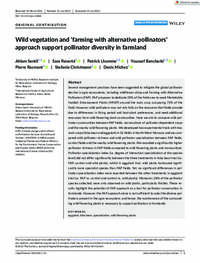Wild vegetation and ‘farming with alternative pollinators’ approach support pollinator diversity in farmland

Authors:
Several management practices have been suggested to mitigate the global pollinator decline in agro-ecosystems, including wildflower strips and Farming with Alternative Pollinators (FAP). FAP proposes to dedicate 25% of the field area to seed Marketable Habitat Enhancement Plants (MHEP) around the main crop, occupying 75% of the field. However, wild pollinators may not rely fully on the resources that fields provide due to differences in flying period and host-plant preferences, and need additional resources from wild flowering plant communities. Here we aim to compare wild pollinator communities between FAP fields, monoculture of pollinator dependent crops and the nearby wild flowering plants. We developed two experimental trials with two main crops (faba bean and eggplant) in 16 fields in North-West Morocco and we compared wild pollinator richness and wild pollinator specialization between FAP fields, control fields and the nearby wild flowering plants. We recorded a significantly higher pollinator richness in FAP fields compared to wild flowering plants and monoculture. Pollinator specialization index (i.e. degree of interaction specialization at the species level) did not differ significantly between the three treatments in faba bean trial (i.e. FAP, control and wild plants), whilst in eggplant trial, wild plants harboured significantly more specialist species than FAP fields. Yet, no significant differences in pollinator specialization index were reported between the other treatments in eggplant trial (i.e. FAP vs. control and control vs. wild plants). Moreover, 28% of the pollinator species collected, were only observed on wild plants, particularly thistles. These results highlight the potential of FAP approach as a tool for pollinator conservation in farmlands. However, the FAP approach alone is not sufficient to cater the diverse pollinators present in the agro-ecosystem, and hence, the maintenance of the surrounding wild flowering plants is necessary to support pollinators in farmlands.
